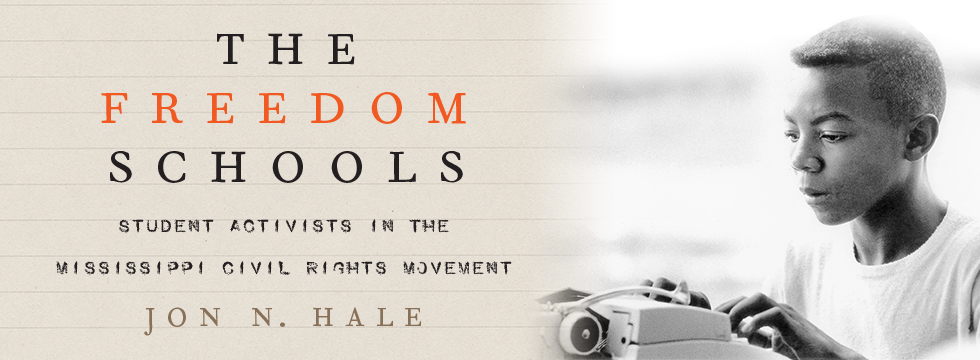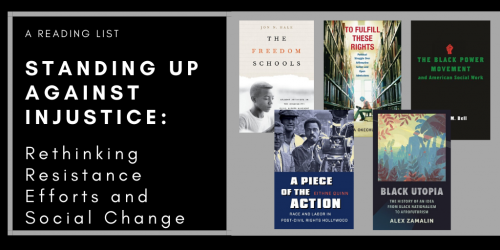Jon N. Hale On The Mississippi Freedom Schools—An Ongoing Lesson in Justice Through Education


In today’s Black History month post, Jon N. Hale, author of The Freedom Schools: Student Activists in the Mississippi Civil Rights Movement discusses the ongoing impact of Freedom Schools, which arose in the South as part of the Civil Rights Movement in the 1960s. He also points to the challenges within Freedom Schools, such as communication between races and white saviorism, as well as the optimism, such as how a grassroots education system can equip local residents in smaller communities with not only stronger voices for change but also for more long-term investment in their own studies, traditions, and culture.
Be sure to enter the book giveaway for a chance to win a copy of the book!
• • • • • •
Reexamining the history of the Freedom Schools during Black History Month is rewarding, but not in the typical ways where we can shallowly reflect on the accomplishments of African Americans and liberal white allies, historically bracketing their work in uncritical, celebratory ways. Instead, the history of the Freedom Schools illustrate just how much further we have to go in actualizing the goals of student and teacher activists of the 1960s.
As I write in The Freedom Schools: Student Activists in the Mississippi Civil Rights Movement, nearly 1,000 volunteers—mostly all white—descended on Mississippi during the summer of 1964 to break the back of Jim Crow. Hundreds volunteered to teach in the Freedom Schools—a grassroots education program during the summer of 1964 for elementary, middle and high school students. Students learned about black history and culture. They read black authors. Teachers introduced them to the art of local organizing and activism. The Freedom Schools were part of the larger plan to challenge segregation, to embrace and spread the nonviolent philosophy, and to organize local communities who would sustain the struggle after the end of the summer.
Though well-intentioned, whites often struggled. They misunderstood the history and background of their students and their families. They underestimated the level of engagement students had already undertaken in the Civil Rights movement. Mississippi had been organized through voter registration drives and uplift initiatives of local branches of the NAACP since WWII. Some students, like Hezekiah Watkins, had already been arrested. He was thirteen in 1961 when he went to greet the Freedom Riders who attempted to desegregate the Greyhound bus terminal in Jackson. Police rounded him up with the Freedom Riders and carted him off to prison. Young students like Watkins were in a better position to teach novice whites unfamiliar with the exacting conditions of the Jim Crow South than whites could teach them about the movement.
“Young students like Watkins were in a better position to teach novice whites unfamiliar with the exacting conditions of the Jim Crow South than white could teach them about the movement.”
In an early lesson of cultural incongruence, whites often misunderstood the culture of their students. White folk music on an acoustic guitar, popular among activists up North, was often out of tune in Mississippi. Renditions of Bob Dylan’s “Blowin’ in the Wind” may have resonated with white youth in New York’s Washington Square Park, but not necessarily black youth who were segregated from public squares across Mississippi that memorialized fallen Confederate soldiers.
One of the lessons that we often miss from the Freedom Schools is that students of color and their families were not there to be “saved.” Whites, in fact, needed a critical education in the dehumanizing system that hampered everyone touched by the grips of Jim Crow, black and white, North and South. Such lessons confirm what James Baldwin wrote in The Fire Next Time: “White people in this country will have quite enough to do in learning how to accept and love themselves and each other, and when they have achieved this—which will not be tomorrow and may very well be never—the Negro problem will no longer exist, for it will no longer be needed.”
“One of the lessons that we often miss from the Freedom Schools is that students of color and their families were not there to be “saved.””
Tragically, the lessons of white saviorism have been lost to history. Today, corporate-driven and highly popular programs like Teach for America have not diverged much from the model of the 1960s. The nation’s best and brightest are given a crash course in teaching and sent to the most underresourced areas of the country to save them. Then, they leave. Instead of investing in parents and the local communities who rely on the schools in the area, programs like TFA are more comfortable trusting young, well-intentioned, well-educated youth to solve educational programs that can only be solved by those who face them on a daily basis.
The Freedom Schools elucidate another moment lost in American history. As the South grappled with desegregation, the Freedom Schools, and the Head Start program that followed it put forth a model that invigorated a collective, localized commitment to public education. Largely threatened by desegregation, whites divested from public schools in the late 1960s and 1970s. White legislators passed laws that provided public funding for new private schools known as “segregation academies.” Whites moved to the suburbs and depleted a tax base that eroded urban public schools. For those who remained in desegregated schools, armed police manned the hallways. Additionally, “school choice” plans became a way for whites to “choose” segregated schools and receive public support for it.
“Freedom Schools offered an alternative vision to divestment and privatization.”
Freedom Schools offered an alternative vision to divestment and privatization. It offered a model of a culturally sustaining pedagogy, investment in parents who use public schools, and local control by families who depended upon the public schools and the teachers who taught in them. This alternative was never incorporated into the mainstream and never received public support. If not for the non-profit efforts of the civil rights activist, Marian Wright Edelman who sponsors Freedom Schools through her Children’s Defense Fund, the Freedom Schools would have ceased to exist.
The Freedom Schools offer a lens through which to examine both the promises and pitfalls of the history of movements for justice through education. As the nation collectively remembers its past during Black History Month, it is crucial that we keep a critical eye on the past and the direction we can take today. Much more than a celebrated program confined to the 1960s, the Freedom Schools offer us today a viable path forward that is firmly grounded in justice.
• • • • • •
Read the introduction to The Freedom Schools: Student Activists in the Mississippi Civil Rights Movement, by Jon N. Hale below! In this work, Hale weaves a social history of the Mississippi Freedom Schools from the perspective of former students and teachers. Having turned their training into decades of activism, they speak on their locally organized, widely transmitted curriculum and offer key strategies for integrating the school system and politically engaging today’s youth








1 Response